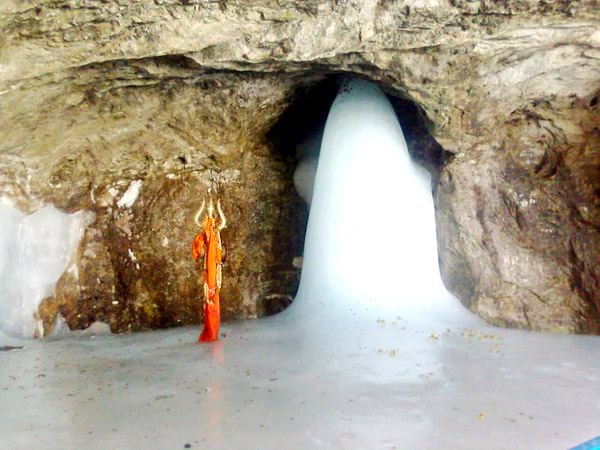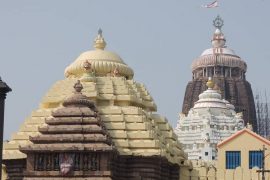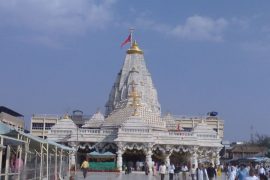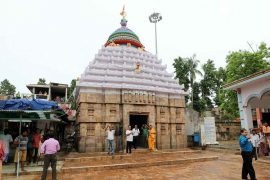This is one of the holy Hindu pilgrimages dedicated to Lord Shiva. Located at an elevation of 3,888m above the sea level in the Northernmost state of Kashmir and Jammu, the Amarnath Cave is known as Lord Shiva’s home and he is enshrined in the form of ice lingam which forms and wanes naturally.

The cave is located in a glacial valley and is 45km from Pahalgam and 145km from Srinagar. It stands at about 150ft high and 90ft long. Inside the cave, there are some ice formations that look like figures of different gods. Of the four figures, the biggest is regarded as Amarnath or Shiva. On the left side of the cave is Ganesh; another ice formation. The right side houses Bhairava and Parvati.
Recommended Information: Amarnath Yatra Tour Package
Amarnath cave receives many visitors; mostly devotees of Lord Shiva who are eager to pay homage to him. Located in a narrow gorge towards the end of the Lidder Valley, the cave has been instrumental in bringing many tourists to the region.

During the months of September and June, the area is covered by snow. The cave is opened in July and August when there is plenty of rainfall. All the same, many pilgrims; over 25,000 in all, brave the rains each year to be there. A visitor can hire a dandy or a pony for the trip to attend the annual Sravana Festival, though it is often crowded. The yearly pilgrimage starts from Srinagar and is led by the holy scepter known as Chhari Mubark.
The place has many stories and myths like most other locations of pilgrimages in India. Legend has it that the cave is more than 5,000 years old and is where Lord Shiva revealed secrets of his immortality to Parvati, his wife. That explains why it is named Amreshwar or Amarnath.
Trekking to Amarnath Cave
From Pahalgam;
The original pilgrimage had the journey beginning from Srinagar before winding its way through Yatra. The most common way however, has the journey beginning from Chandanwari before covering the distance to Amarnath and back within a record five days. From Srinagar, Pahalgam is 96km and trekking from Chandanwari to the cave is on an ancient route, though it is unfamiliar. On the first night, pilgrims camp at Pahalgam or Chandanwari.
From Chandanwari, pilgrims trek through a 12km route on the first day. It winds through a primitive yet magnificent countryside with the center of attraction being Sheshnag. This is a mountain that derived its name from seven peaks that look like the head of a legendary snake. Another site to behold is a stream gushing out water to the wild scenery that has remained unaffected by modern civilization. On the second night, people camp at Wavjan where they face the blue waters of Lake Sheshnag as they listen to tales of revenge and love associated with Sheshnag.
On the second day, pilgrims continue with the trek that steadily gains height as it winds across Mahagunas Pass at 4600m before a sharp descent to the meadows of Panchtarni which is the last camp to Amarnath Cave.
An early morning start is recommended from Panchtarni to Amaranth which is a distance of 6km. This is necessary to avoid long queues as many people are usually eager to get to the cave. Devotees can then return to Panchtarni for lunch before proceeding to Sheshnag for the night.
From Baltal;
Another way to approach Amarnath is from Sornamag through Baltal which stands at 300mts. Sornamag is located along Srinagar-Leh road on the northeast. Baltal lies 15km ahead and is a pretty little valley that lies on the foothills of Zojila Pass. To get to the cave, caution has to be observed because the slope is rather steep and the trek is a day’s journey. At the top are Brarimarg and Sangam which are tea stalls. There are a number of snow bridges across fast flowing streams that get very slippery during the rainy seasons. At the top of Sangam, the road meets Pahalgam route. At Baltal, porters and ponies are available at fair government approved rates.
The Amarnath Legend;
As earlier written, there are myths describing the Amarnath Cave. A famous Rigvedic verse says “Ekam Sat” meaning “Only one being exists and is known by many names”. God who is also known as Parmeshwar, has three deities that carry on the world and is referred to as The Holy Trinity. Brahma is the creator, Vishnu the perpetuator of life and Shiva, the purifier and perpetuator of good yet destroyer of evil. In the Rig Veda, Shiva is also referred to as Rudra in the below verse;
“We worship Tryambaka (Rudra), who spreads fragrance and increases nourishment. May he release me like a cucumber from its stem, from mortal life but not immortality”.
According to the Yajurveda, Shiva is an ascetic worrier whose robe is made of deer skin and carries Tishul. The verse says life has three facets of; Truth(Satyam), Good, (Shivam) and Beautiful, (Sundaram). Sacred and ancient Indian books narrate the existence of Shiva in the hymns. The rig veda confirms his presence and further says he has three places of residence. One is at Kailash Parvat, second; Lohit Girl and Muzwan Parvat is the third.





Comments are closed.